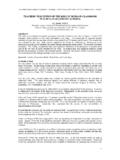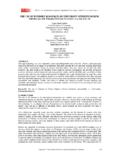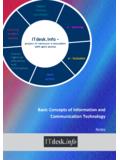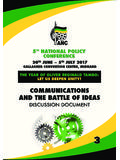Transcription of WHAT TECHNOLOGY PLAYS SUPPORTING ROLE IN …
1 The Turkish Online Journal of Educational TECHNOLOGY TOJET April 2006 ISSN: 1303-6521 volume 5 Issue 2 Article 10. what TECHNOLOGY PLAYS SUPPORTING ROLE IN LEARNING. CYCLE APPROACH FOR SCIENCE EDUCATION. Hakan TURKMEN, PhD. Department of Instructional Leadership and Academic Curriculum University of Oklahoma ABSTRACT. There has been a movement nationally over past several decades to integrate TECHNOLOGY into extent curriculum. This is true both at the K-12 level and in higher education. The purpose of this study is to show what role science education has played in this effort ( , what documents, research or associations provide positions on TECHNOLOGY usage) and what role TECHNOLOGY should or could play in a learning cycle approach in the light of current research. In this study, first of all, the concepts of TECHNOLOGY and educational TECHNOLOGY including a rationale for the use of TECHNOLOGY in education were examined in historical perspective and then what relationship between Learning Cycle approach and educational TECHNOLOGY in science education was showed.
2 As a result, how we can create TECHNOLOGY -based curriculum in our learning cycle approach and how we, as teachers, can use TECHNOLOGY in learning cycle approach will shown. Keywords: TECHNOLOGY Integration, Science education, Learning cycle approach INTRODUCTION. TECHNOLOGY has an impact on every aspect of modern life. However, TECHNOLOGY has by passed the classroom. It is time to more fully integrate TECHNOLOGY into the educational settings since skillful use of TECHNOLOGY supports the development of process skills such as higher order skills, adaptability, critical thinking, problem solving, and collaboration that are essential to succeed in our rapidly changing information age. If we ask what technological tools in school are, most of people would say first computers and computers represent the only educational TECHNOLOGY available. This, of course, is not true since there are many different kinds of TECHNOLOGY in the classroom. While computers and their related devices (probeware, electronic databases, CD-ROMS, the internet, and multimedia presentations) are part of TECHNOLOGY , and also overheads, televisions, VCR, digital cameras, videodiscs, and traditional science equipment are too.
3 Today's kids needed today's learning media to become engaged in the learning process. This thought was confirmed by a quote I found in the work of John Dewey, Educational Philosopher, written more than a century ago. If we teach today as we taught yesterday we rob our children of tomorrow (Dewey, 1916). TECHNOLOGY lets us better serve the diverse learning styles of our students and educate them for a wider range of intelligence. TECHNOLOGY IN HISTORICAL PERSPECTIVE. There are many good examples of using of technological resources to enhance learning in science classrooms. There is no doubt that a rapid increase in technological resources has a revolutionary effect on teaching of science (Windelspecht, 2001). However, using TECHNOLOGY in science classrooms is not common in schools yet. A little research on education history will show the reason behind this fact. Before 1800, instruction at both elementary and secondary levels was predominantly individual.
4 The standard practice was for the village schoolmaster to call one or several pupils to his desk, and teach individually. The Lancasterian monitorial system, developed by Englishman Joseph Lancaster, provided the basis for the eventual support of free public schools at the end of the 18th century, and spread in the beginning of 19th century. The method relied heavily on using the advanced students to teach the younger ones. By the Lancasterian system, large-group instruction started and classrooms were constructed that would make the most effective use of instructional media and student grouping. Under this system, one master taught a select group of older pupils, the monitors, and these in turn taught the rest. Lancasterian system is a system which is, in education, what he neat finished machines for abridging labor and expense are in the mechanical arts (Spring, 1990). In the early 1900s, the educational community in modern countries found a new ideology, called the meritocracy movement.
5 The Meritocracy movement claimed that education and educational phenomena could best be studied through the use of current scientific paradigms. Moreover, this new ideology suggested that human intelligence itself could be effectively measured through the use of scientific techniques. At that time, there were limited technological tools, blackboards, desks, pencils, notebooks, basic mathematical tools, used in American schools. By the early 1900s, many important technological inventions, such as telephones, electrical lighting, automobiles, had occurred. Electricity especially opened a huge door in the education. Teachers were able to 71. The Turkish Online Journal of Educational TECHNOLOGY TOJET April 2006 ISSN: 1303-6521 volume 5 Issue 2 Article 10. give their lectures at night, even though students had been working at night already. By the 1950s, photography, photojournalism, sound motion pictures, and broad radio firmly established American educational traditions.
6 These inventions were very useful for education, because, in the 1920s and 1930s, industries were successful in convincing the educational community that film and radio were especially capable of shaping public morality, improving educational teaching perspectives, and firmly entrenching American educational goals. However, these new technologies did not turn educators away from print-based cultures (Engle, 2001). Print-based culture started with the invention of the Gutenberg press in 1492. Steinberg (1961) asserted, The history of printing is an integral part of the general history of civilization (p. 89). By many educational historians, the importance of the printing process is clearly confirmed in the many stages of education. World education was negatively influenced by World War II. Business interests, the scientific community, and military leaders criticized the education system in their countries in the 1940s and 1950s. In 1958, American Congress passed the National Defense of Education Act, in hopes of constructing the indifference of American schools towards the declining scientific and technological progress in education, caused by financially driven factory-style schools.
7 By through 1960's, network television was adopted in the modern countries life. Two-thirds of Americans reports and most of their information about the world were being watched via television, but many researchers and educators realized that the rise of the television society left education in a poor position. By 1970's, science teachers began to use the overhead projector, which show diagrams, charts, or figures that clearly indicate analysis of the topic, pictures. This device has now become a traditional use of TECHNOLOGY in the classroom. Slides, slide shows, and documentary videos are also very useful technological tools for students, especially for editing, observing, interviewing, and investigating. Clearly, the most important invention is the computer and now the most popular tool. Konrad Zuse invented the first computer in 1936 but it was not used until World War II in public. In addition, computer did enter the classroom after the 1980's.
8 In the last decade, we have seen an explosion in using the computer in education. A. Nation at Risk in the US (1983) cited computer competence as a fourth basic skill that was both an important and empowering experience in the world in which we live. Accordingly, computer skills are needed for both subsequent formal educations as well as for one's individual life experiences (Gilder, 1993). Currently, three major national projects are underway in the United States that are designed to restructure science education and develop scientific literacy. The Project 2061 (American Association for the Advancement of Science, 1993), the National Science Education Standards (National Research Council, 1996), and National Educational TECHNOLOGY Standard (International Society for TECHNOLOGY in Education [ISTE], 2002) emphasized how important of educational TECHNOLOGY and increased the awareness and interest of science for educators, students and average citizen.
9 According to The Office of TECHNOLOGY Assessment, in 1988, 95% of all American schools have one or more computers (Mistler-Jackson and Songer, 2000). There is no doubt an increasing trend of using TECHNOLOGY in the education system, especially since computers that collect, display evidence, and summarize, as a part of these standards, started to be seen the most important tool to improve student learning (Pedersen & Totten, 2001). If TECHNOLOGY is to become an integral part of K-12 and higher education, then it must also become an essential part of instructional tools and teacher preparation programs. Although educators know how important and useful technological tools are in the classroom, they still lack TECHNOLOGY efficiency in science classes. Davis and Falba (2002) stated that traditionally, TECHNOLOGY has not been central to teacher preparation experience in most colleges of education. Similarly, Pedersen and Yerrick (2000) reached the same conclusion in that; inadequate preparation of TECHNOLOGY continues to be problem.
10 Many teachers need training and support in the use of new methods and new media, in their research. According to Czerniak and Lumpe (1995), only 16% of teachers reported using TECHNOLOGY almost everyday and 28% reported using it several times a week. Most frequently, teachers are using TECHNOLOGY for communication such as email and telephone system (Frank & Zhao, 2003). Odom, Settlage and Pedersen (2002) had found almost same results that small differences were found for telecommunication and word processing. However they found large differences in teaching students at a distance, database applications, support research efforts, and desktop publishing areas of using TECHNOLOGY as an instructional tool in their research. These results mean that our teachers know enough information about using TECHNOLOGY in telecommunication and word processing but they need to be taught in other areas of using TECHNOLOGY . In spite of this, the trend of using TECHNOLOGY in schools is rapidly increasing.







